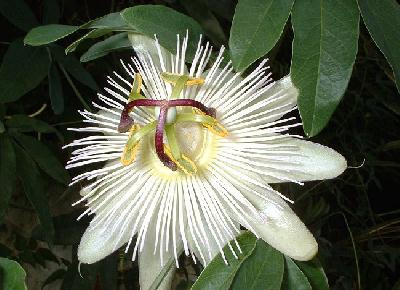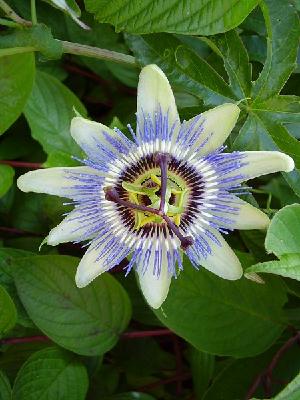Passionflower (Passiflora)
By Debs Cook
Looking at the picture below, you'd expect to discover that I'd recently been on holiday to some exotic place photographing tropical plants? Would you be amazed to learn that these photos were taken not that far from my home in Derbyshire? The first photo was taken in the gardens of a place called Calke Abbey (pronounced Cork); the other two were taken in my father-in-law's garden, last August. I was amazed to see such a beautiful and exotic looking plant growing at the bottom of an otherwise ordinary and plant empty garden. I eagerly picked a couple of the fruits, removed some of the seeds and tried to grow a plant for my garden. Sadly, the seedlings never emerged, but I have it on good authority that I can grow a passionflower from a cutting, so when the new growth appears soon, I'll have a go.

Passiflora 'Constance Eliott'
A couple of trips around the garden centres recently, left me amazed at how many different flower types and colours of passionflower there are. Never having given passiflora more than a cursory glance for it's sleep inducing properties, in teas, tinctures, and sleep pillows, I'm now firmly hooked on the plant, for it's beauty as well as it's medicinal uses, and thought I'd share this easy to grow and exotic looking herb with you all this month.
History
Passiflora most commonly known as Passion flower, Maypops and also Maracuja in the Amazon was first discovered in Peru in 1569 by the Spanish Doctor Nicolás Monardes (c1493 - 1588). The species was later classified in 1745 by Carl von Linné (c1707 - 1778) when he recognised 22 species. In the 1800's the passiflora became popular with the Victorians when the hybridisation of the passionflower began. To date, there are thought to be over 600 different forms of passiflora.
Folklore
The name passionflower would lead one to automatically associate it with love and passion, but in folklore the plant has more been associated with calm and peace, only in recent history has it been associated with passion in the romantic sense. The passion in the passionflower refers to the Passion of Christ, it's said that the 3 stamens represent the wounds of Christ, the sepals represent the apostles, and the corona (the frills around the stamens) are said to represent the crown of thorns.
The passionflower is also claimed to help you make friends and increase your popularity.
Description

Passiflora Caerulea
The passionflower is extremely fast growing, and is a hardy climber, more often referred to as a vine, that can grow up to 10 metres. It uses tendrils to help itself cover walls and fences. The flowers look very exotic and come in a range of colours from white through purple to a delightful flame red. The purple variety Granadilla (Passiflora incarnata) is the most common form of the edible passion fruit that is grown worldwide; it produces egg shaped fruits filled with a fruity tart, bright orange pulp. The Blue Passionflower (Passiflora caerulea) is the variety most often found in the UK. Other passiflora species worldwide include the banana passion fruit (Passiflora mollissima), the water lemon (Passiflora laurifolia) and the sweet granadilla (Passiflora ligularis).
Growing
The Passionflower comes into flower in July and continues flowering until late September. Passiflora doesn't require too much fuss to get it to grow; in fact, some people complain that it can be too prolific. It prefers a soil that is on the sandy side, free draining and not rich. If your soil is too rich and fertile then your passionflower may grow leaves only and no fruits or flowers. Plant your passionflower in full sun if possible, and make sure the soil is free draining.

Passionflower
General Use
Passionflowers can be dried and used in pot-pourri blends, the fruit oil can be used as flavouring for cosmetics and as scent in bath products. The dried leaf and flowers can be combined with other herbs such as hops, chamomile and lavender to make a fragrant and soothing herbal sleep pillow. The dried leaf can also be made into a bath tea with other soothing herbs such as lavender and rose petals to make a wonderfully fragrant and relaxing bath blend.
Medicinal Use
Medicinal the parts of the passionflower used are the flowers, leaves, and stems. Passionflower contains Passiflorine which has been likened to morphine; no wonder passiflora is used to help treat neuralgia and insomnia. The variety commonly used medicinally is Passiflora incarnata also known as the purple passionflower or Maypop. As well as the two medicinal uses already cited, the herb is used to treat nervous tension, irritability, irritable bowel syndrome and premenstrual tension. An infusion of the plant is useful for treating back pain, due to its anti-spasmodic action. Passiflora contains alkaloids and flavonoids that are an effective and non-addictive sedative that does not cause drowsiness.
Warning
Do not take passionflower if you are pregnant or breastfeeding. Passion Flower should not be given to children under the age of 2.
Culinary Use
The orange, egg-shaped fruit of Passiflora incarnata is edible, although it is not as tasty raw as the purple fruiting variety Passiflora edulis, sold in shops and supermarkets. The purple passion fruit has a wonderfully fragrant pineapple-orangey scent and makes refreshing fruit sorbet and drinks, either on its own or when added to other fruits such as the mango. Passion fruit can be made into jams, chutneys, syrups, jellies and puree, which makes an excellent filling for cakes. It is also a good source of vitamins A and C, and potassium.
